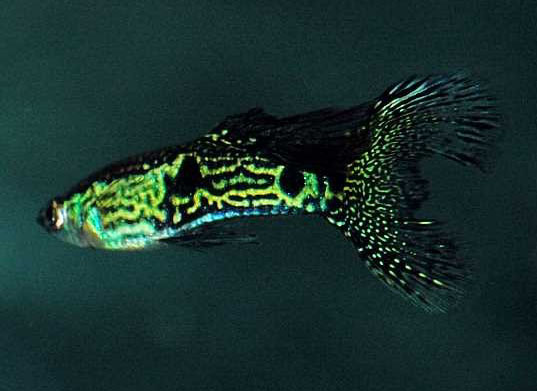Art XVII
Guppy: new Types anno 2020
RUBRIEK: Guppy Kweek English Translation
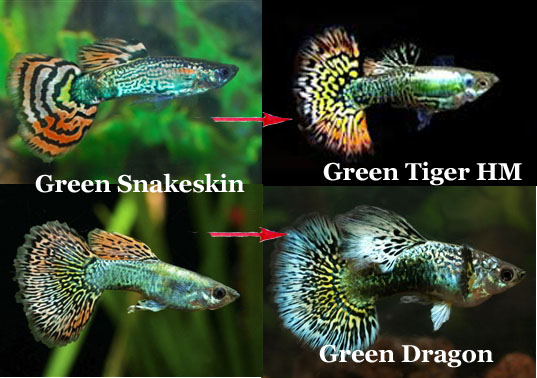
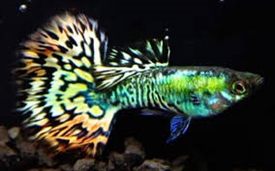
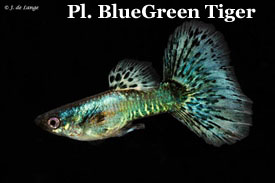
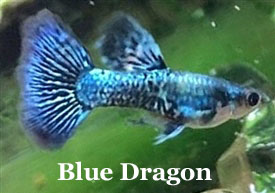
A number of new types have definitely broken through in the guppy world this year. This has not been done through the traditional guppy clubs, but through the guppy breeders, and more specifically in the guppy farms in Asia. These new types are therefore not yet recognized as such as new "strains" and not yet incorporated into the standards, but that is already happening in Asia, so if Westerners are buying these as export animals - an evolution underway - they will will be included in that list in the foresee-able future.
What types are we talking about? Well, there is actually a new generation of crossing products between Snakeskins and Half Blacks . More than 10 years ago, hybrids that were called Green Tiger regularly appeared. These were obtained by crossing Snakeskin or King Cobra with Tuxedo, and those guppies were named Tiger because of the Zebrinus stripes on the their rear body. From the Tuxedo they often brought not only the Platinum with them, which gives a nice shine to the front body, but also a slightly shorter tail fin that is wider and rounder. Further breeding then produced specimens with beautifully fanned tail fins that were named Half Moon (HM) to even Full Moon , and as such have become popular in a short time ( see photo above).
Another cross product of these two strains is the Dragon , which shows slightly more characteristics of the Half Black - the caudal black is clearly noticeable - and due to the input of the Tuxedo genes has a more shred-ded pigmentation. The mixing of the Mosaic drawing in the caudal fin of the Tuxedo, and the Lace drawing of the Snakeskin, has resulted in the Dragon's tail drawing consisting of fanned-out stripes, which further enhances the "Moon effect".
Most common are the green, yellow and red hybrids (see photo below). After a while they also obtained blue and other color varieties, but those eyes a little less tight because as well blue can harmonize with other colors, it can appear as a main tone with a lot of black a bit dull and "dirty".

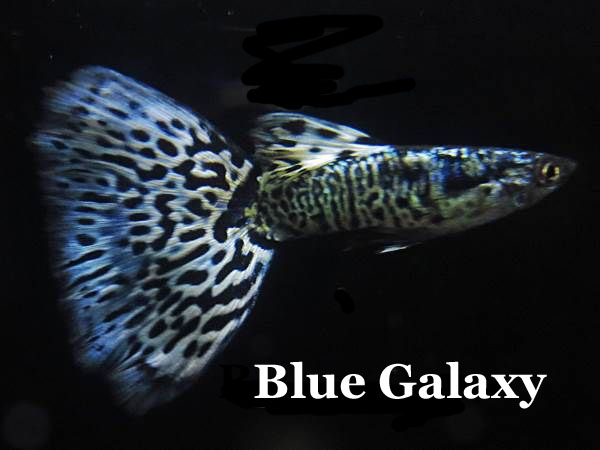


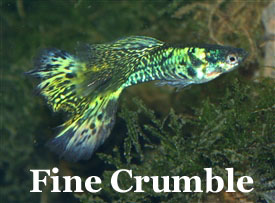
One has gone even one step further. After all, the black pigmentation can show other patterns. If we take a closer look at the Galaxy (see photo on the left), one can see that the "bandit" drawing can take on very erratic shapes, and may or may not be accompanied of additional, similar drawings. The combination of Snakeskin drawing with the "Pixel" drawing of the Tuxedo, can thus also create a kind of crumb pattern spread over the WHOLE body. I have therefore appropriately named this pattern the Crumble drawing. As far as I know, nobody has noticed this pattern so far, so I take the honor of being the first to pick a name. To be clear: I did not breed these guppies myself; but the child may have a name.
The interesting thing about this pattern is its whimsy . In all probability, that is also the reason why it has still not been registered as a strain until now: it can range from a kind of thick Zebra stripes, to a number of irregu-lar puzzle pieces, with a whole repertoire of patches and stripes in between. The more the Tuxedo nature weighs in, the coarser the drawing can beco-me. In the photo on the left, they can be seen as thick, uneven stripes - Gross Crumble -. On the contrary, the more the Snakeskin nature weighs, the more finer the pattern can become. In the last photo on the left, one can see a drawing that is not that so far different from the Galaxy, but that runs all over the body: Fine Crumble .
If you think this is the end of it, you are wrong. The same can "happen" with that other fixed back body pattern (besides Half Black): Japan Blue. The photo below shows how this pattern, which normally consists of one coherent and even cover layer, can also disintegrate or shred into a random network of strong and weakly occupied pieces. No more uniform "pants", but more a kind of "modern jeans" with all kinds of tears and holes. And in all fairness: that also looks nicer, because the alternation of paler and darker parts, or brighter and weaker colored zones, gives a depth . It looks more like a relief map of mountains and valleys than a floor covered with a carpet. The fixed genome that was Japan Blue up to now seemed monotonous and little nuanced. Now that that pattern is apparent-ly a bit cracked because it has been broken open, it allows more slack.
The question is, of course, HOW it is exactly inherited. Because Japan Blue was initially, together with the Tuxedo, one of the easiest strains to breed due to its uniformity and its uniform and constant inheritance. Now that the fixed genome has been broken open, it will take greater effort to breed these beautiful new fish. Only a certain percentage will be like this, I esti-mate, and so there will be more "waste" with downright defective or bad coloring. Breaking open pieces of fixed genome is done by regression , and is therefore always accompanied by a loss.

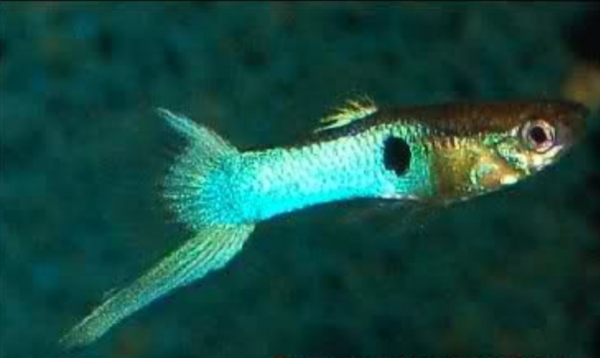
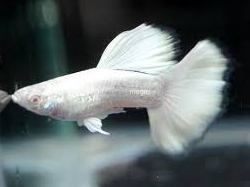
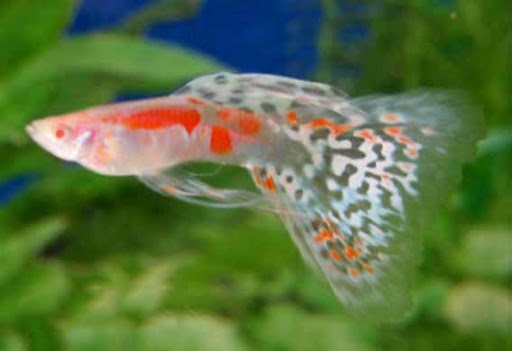
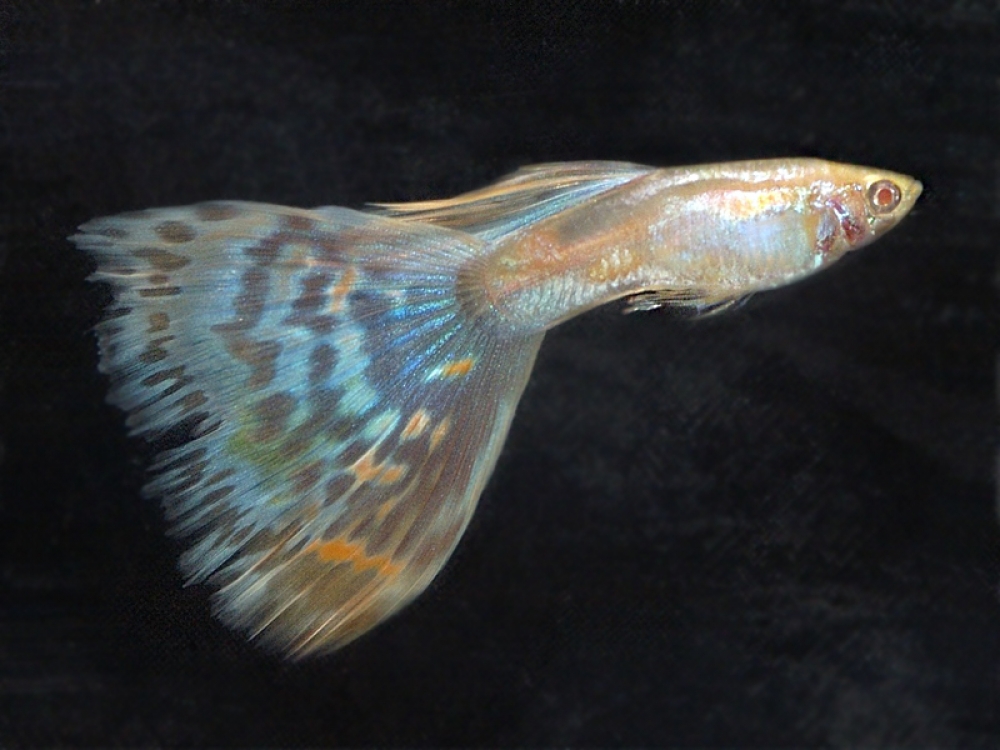

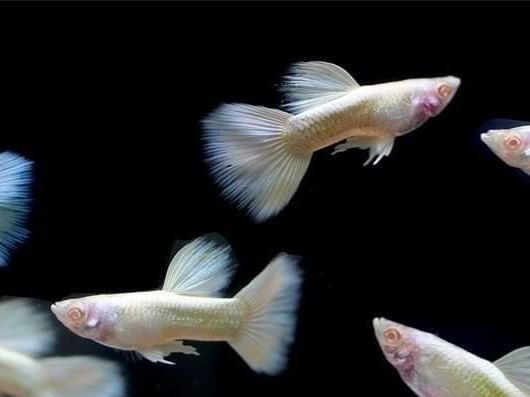
The same pursuit of depth characterizes the revival of the albino . Just as a reminder: in albino, all "coatings" are actually stripped off because they become transparent. So an albino is actually a guppy who does streap-tease : he has pulled out all jackets and all clothes and stands "in his un-derpants". Now, what applies to humans, also applies to albino: not every-one looks great in his underpants. So what applies to Cristiano Ronaldo does not apply to everyone. The same goes for albinos: as recessive homo-zygotes they look rather flat and pale, if they do not also have some genes for color nuances. Let us not forget that the main use of albinos in guppy breeding has so far mainly been to let "disappear" other, disturbing genetic material in monochrome color strains. With albino white, for example, one does not see anymore the black spots or colored zones that can be seen with the normal colored gray form.
So care must be taken to make WELL use of this ability. Strippers are known to go to the tanning bed for a more beautiful complexion: nothing is as ugly as showing off a glaring white skin that has never been lit by sun-light. For the same reason, most albinos look dull and pale. I once got frictions about this on a Facebook: why I had to say that I did not like a certain albino. The reason for that was simple: because it was not really a beautiful fish. One has to get rid of that ugly habit of only wanting to give compliments and likes on Facebook. A little more critical sense and honesty would make a big difference. One must emphasize originality, and not just follow indiscriminately the mainstream.
Anyway, back to the albinos. Below is a good example of how softer color nuances and drawings can still shine through with an Albino Blond Snake-skin. This I find for sure a nice guppy. Please note that, just like with the Gingas, the combination with blond can give a nice result. This combina-tion is 5-fold recessive, so it will take a few generations to get the strain that way. Compare that with the albinos in the left column, and make your own evaluation and conclusion. I say no more!
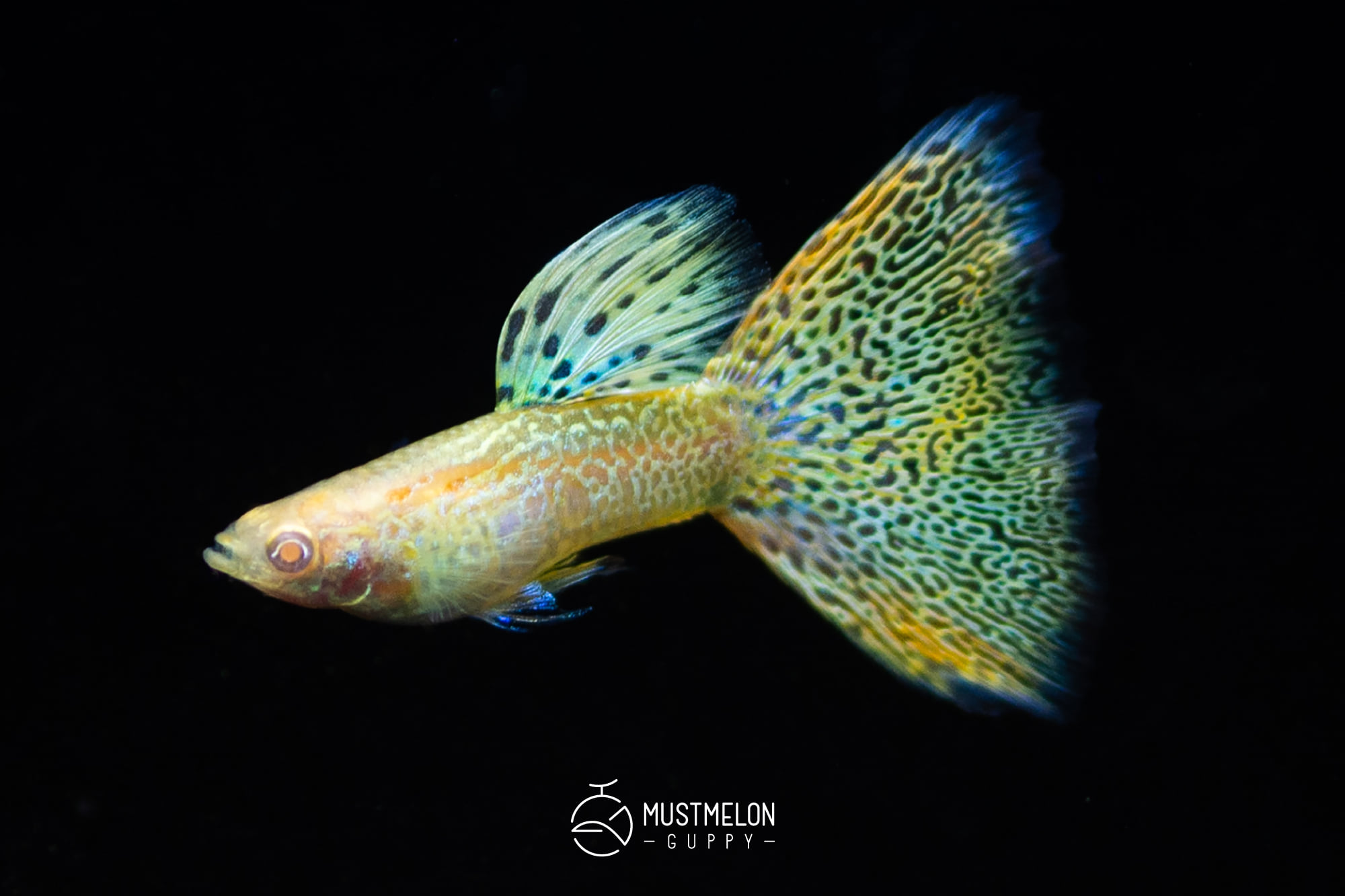
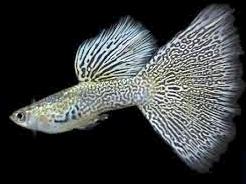
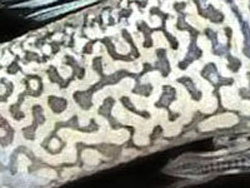
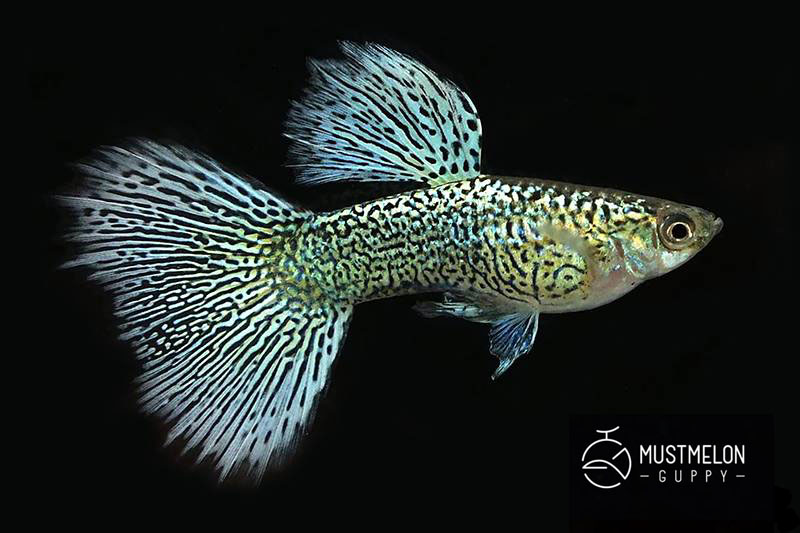
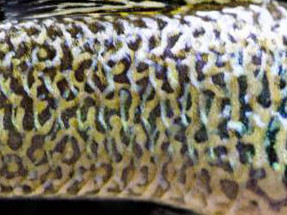
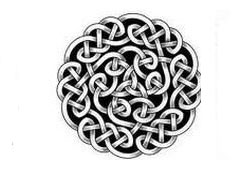
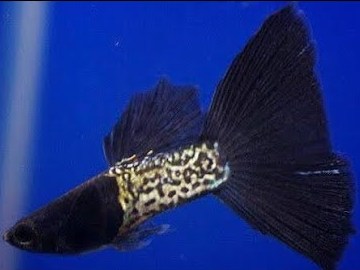
The Snakeskin itself is also subject to a number of innovations. First as a reminder, an "old-fashioned" Lace , as we have known it for a number of decades, and during that time has seen a number of improvements such as a larger caudal fin and a larger dorsal fin; but otherwise remained virtually identical.
A first innovation is that the filigree motif became more compressed and therefore denser. It can be clearly seen that there are more "dots" present. Comparing in detail the drawing of an antique Lace with that of a modern version, one can see that the filigree drawing of the latter consists of a braid of 3 different lines (white, gray or black, and gold) that are inter-twined like Celtic knots (see figure at the bottom left).
Together with Metallic and Gold , this literally and figuratively gives this old Guppystrain a new shine , but for colors other than WHITE, one can also wonder whether this busy design is not becoming a bit "too much". For example, a new car may shine a little, but when a red sports car shines and sparkles like a reflection mirror, it is a bit "over". In other words, the limit is reached here too, and the pattern has become so dense that it leaves nothing to the imagination.
Now a difficult moment: the Black Lace is another novelty that is grown in New Zealand as well as in Asia. Because it brings this brain-teaser: is the zebra a black animal with white stripes, or a white animal with black stri-pes? Likewise, is the Lace a guppy with a black stripe pattern and white spaces, or white stripes and dark spaces? In practice BOTH seem to occur, depending on the basic colors of the guppy involved. What is meant by this Black-Lace, is that the tone of the gray stripes has darkened to an intense ink-black. I have a suspicion that it originally comes from a hybrid with an Endler, but I am not entirely sure. The fact is that he often shows up among breeders specializing in Endlers, or it must be that this mutation suddenly showed up spontaneously in crosses between Snakeskin strains. Anyway, there is NO WHITE involved in this Black Lace.
Whatever the case, the females are actually almost more beautiful than the males, as they ALSO display the filigree motif in their rear bodies, and can show extraordinarily beautiful finch colors by guppy female standards. In males, the contrast with the "extra-black" works a bit wrong, because it mutes the paler colors in the tail. If one succeeds in introducing brighter colors to that caudal fin, these can become real gems. But apparently that could take a while. Initial Black-Laces are Snakeskins of a certain color with a BLACK side drawing. I have noticed that people often depict black Snakeskins with a WHITE side drawing as "Black Laces". Strictly speaking, this is not correct, because they are actually the negative of it, and should be called Black Snakeskins with White-Lace (see last photo). Do not panic! Remember: the network or lace is constructed with threads of 3 colors.
